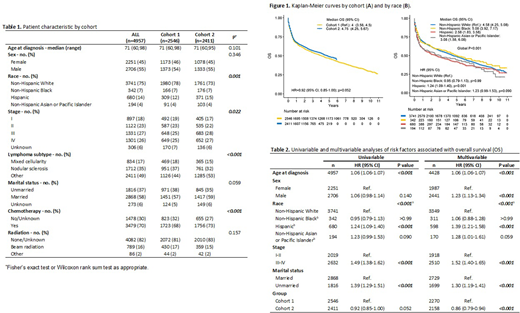Background:
Classical Hodgkin Lymphoma (cHL) patients that are older than 60 years have worse survival compared to those that are younger due to aggressive biology and treatment-related toxicities. Approval of novel agents such as brentuximab (2011) and checkpoint inhibitors (2016) in the relapsed/refractory setting has changed the treatment paradigm of cHL. To assess the effect of novel therapeutic agents on the survival of elderly cHL patients over time, we conducted a SEER 18 registry analysis (released Nov 2018) of cHL patients greater than 60 year old and compared outcomes of those diagnosed between 2006-2010 (before approval of novel agents) to those diagnosed between 2011-2015 (novel agent era).
Methods:
Patients from SEER 18 registry (released Nov 2018) with cHL and age 60 or greater were included in this study. Cohort 1 included patients from pre-novel agent era (diagnosed from 2006-2010) and cohort 2 included patients from novel agent era (diagnosed from 2011-2015). Last follow-up was available until Dec 2016. Kaplan-Meier estimates were used to summarize the distributions of OS . Univariable and multivariable Cox proportional hazards regression models were fit to assess associations between prior chosen factors (age, sex, race [Non-Hispanic White (NHW), Non-Hispanic Black (NHB), Hispanic (H), Non-Hispanic Asian/Pacific Islander (NH A/P)], stage at diagnosis [I-II vs III-IV], marital status [married vs others], treatment-era [pre-novel agents vs novel agents era] and OS. Sensitivity analysis was explored to adjust the effect of follow-up duration difference between the two cohorts; patients who were in cohort 1 and whose follow-up duration was greater than the maximum follow-up duration of cohort 2 were considered censored at the time of the maximum follow-up duration of cohort 2
Results:
There were total of 4957 patients analyzed in this study. In cohort 1 (pre-novel agent era) there were total of 2546 patients, n=1980 (78%) for NHWs, n=309 (12%) for Hs, n=166(7%) for NHBs, n=91(4%) for NH A/PIs; in cohort 2 (novel agent era), there were 2411 patients, n=1761(73%) for NHWs, n=371(15%) for Hs, n=176 (7%) for NHBs, n=103(4%) for NH A/PIs (p=.001) (Table 1). There was no difference in age at diagnosis, marital status, and sex between the two groups. Cohort 2 had more patients with Stage III-IV disease (55% in C2 vs 50% in C1, with p=.002) (Table 1). In the novel agent era, there were more patients who had chemotherapy "Yes" status compared to "No or Unknown" status (73% with "Yes" in Cohort 2 vs 68% with "Yes" in Cohort 1 with p<.001) (Table 1).
Cohort 1 had median follow-up of 8.33 years and Cohort 2 had median follow-up of 3.33 years. Cohort 1 had median OS of 4 years (3.58-4.25) years and Cohort 2 had median OS of 4.75 years (4.25-5.67) with HR of .92 (.85-1.00); p=.052 (Figure 1a). Hispanics had worse OS compared to NHWs with HR of 1.24 (1.09-1.40) with p < .001; NHBs had similar OS compared to NHWs with HR of .95 (.79-1.13) with p> .99 (Figure 1b). In the univariable analysis (UVA) to assess risk factors associated with OS, older age at diagnosis, Hispanic race, Stage III-IV and unmarried status were associated with worse OS. In the multivariable (MVA) analysis to assess risk factors associated with OS, older age at diagnosis, male gender, stage III-IV, unmarried status, Hispanic race and pre-novel agent era were associated with worse OS (Table 2).
In the sensitivity analysis, HR was for OS was .92 (.85-1.00) with p=.039 for Cohort 2 (novel agent era) compared to Cohort 1 (pre-novel agent era). In the sensitivity analysis, the difference in OS between the NHWs and Hispanics remained; UVA and MVA for risk factors associated with OS remained the same after this adjustment also.
CONCLUSION:
In this SEER analysis, we found that elderly cHL patients who were diagnosed with cHL after novel agents such as brentuximab and CIs were approved (2011 and after) have improved survival by about 9 months compared to patients diagnosed before the approval of such agents (2006-2010). The improved survival likely reflects better efficacy and tolerability of these agents in elderly population as opposed to cytotoxic chemotherapy options. Lastly, we did not see any difference in survival of NHBs compared to NHWs unlike in previous SEER analysis; however, Hs still had worse OS compared to NHWs. In conclusion, OS of elderly cHL patients is improving in the novel agent era.
No relevant conflicts of interest to declare.
Author notes
Asterisk with author names denotes non-ASH members.


This feature is available to Subscribers Only
Sign In or Create an Account Close Modal